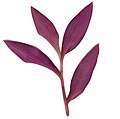Tradescantia pallida
| Tradescantia pallida | |
|---|---|

| |
| Tradescantia pallida | |
| Scientific classification | |
| Kingdom: | Plantae |
| Clade: | Tracheophytes |
| Clade: | Angiosperms |
| Clade: | Monocots |
| Clade: | Commelinids |
| Order: | Commelinales |
| Family: | Commelinaceae |
| Subfamily: | Commelinoideae |
| Tribe: | Tradescantieae |
| Subtribe: | Tradescantiinae |
| Genus: | Tradescantia |
| Species: | T. pallida
|
| Binomial name | |
| Tradescantia pallida | |
| Synonyms[1] | |
|
Setcreasea pallida Rose | |

Tradescantia pallida is a species of spiderwort (a genus of New World plants) more commonly known as wandering jew or walking jew, a name it shares with the closely related species T. fluminensis and T. zebrina. Other common names include purple secretia, purple-heart,[2] and purple queen.[3] It is native to the Gulf Coast region of eastern Mexico. Edward Palmer collected the type specimen near Ciudad Victoria, Tamaulipas in 1907.[4][5]
Names
The Latin specific epithet pallida means “pale”.[6] The common name “wandering jew” may refer to a widespread myth of medieval origin.
Description
Tradescantia pallida is an evergreen perennial plant of scrambling stature. It is distinguished by elongated, pointed leaves - themselves glaucous green, fringed with red or purple - and bearing small, sterile three-petaled flowers of white, pink or purple. Plants are top-killed by moderate frosts, but will often sprout back from roots.[7]
Cultivation
Widely used as an ornamental plant in gardens and borders, as a ground cover, hanging plant, or - particularly in colder climates where it cannot survive the winter season - houseplant, it is propagated easily by cuttings (the stems are visibly segmented and roots will frequently grow from the joints).
As a houseplant, T. pallida has been judged exceptionally effective at improving indoor air quality by filtering out volatile organic compounds, a class of common pollutants and respiratory irritants, an effect known as phytoremediation.[8]
Numerous cultivars are available, of which 'Purpurea' with purple foliage has gained the Royal Horticultural Society's Award of Garden Merit.[9][10]
Gallery
-
leaves,
superior aspect -
leaves,
inferior aspect -
flower
-
Close up shot of flower
References
- ^ "Tradescantia pallida". Germplasm Resources Information Network. Agricultural Research Service, United States Department of Agriculture. Retrieved 2011-11-20.
- ^ "BSBI List 2007". Botanical Society of Britain and Ireland. Archived from the original (xls) on 2015-01-25. Retrieved 2014-10-17.
- ^ USDA, NRCS (n.d.). "Tradescantia pallida". The PLANTS Database (plants.usda.gov). Greensboro, North Carolina: National Plant Data Team. Retrieved 14 December 2015.
- ^ "Tradescantia pallida". EOL. Retrieved 24 March 2018.
- ^ "Tradescantia pallida" at the Encyclopedia of Life
- ^ Harrison, Lorraine (2012). RHS Latin for Gardeners. United Kingdom: Mitchell Beazley. ISBN 184533731X.
- ^ Duever, Linda Conway (2006-08-31). "#734 Tradescantia pallida". Floridata.
- ^ Yang, Dong Sik, Pennisi, Svoboda V., Son, Ki-Cheol, Kays, Stanley J. Screening Indoor Plants for Volatile Organic Pollutant Removal Efficiency. HortScience, Published online 1 August 2009; in print 44: 1377-1381 (2009)
- ^ "RHS Plant Selector - Tradescantia pallida". Retrieved 5 July 2013.
- ^ "AGM Plants - Ornamental" (PDF). Royal Horticultural Society. July 2017. p. 102. Retrieved 24 December 2018.




